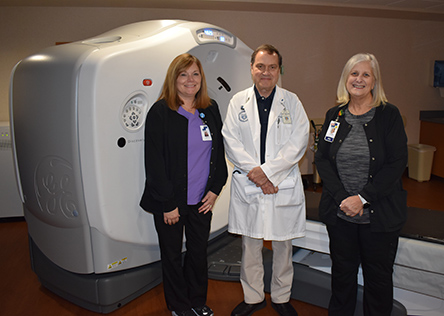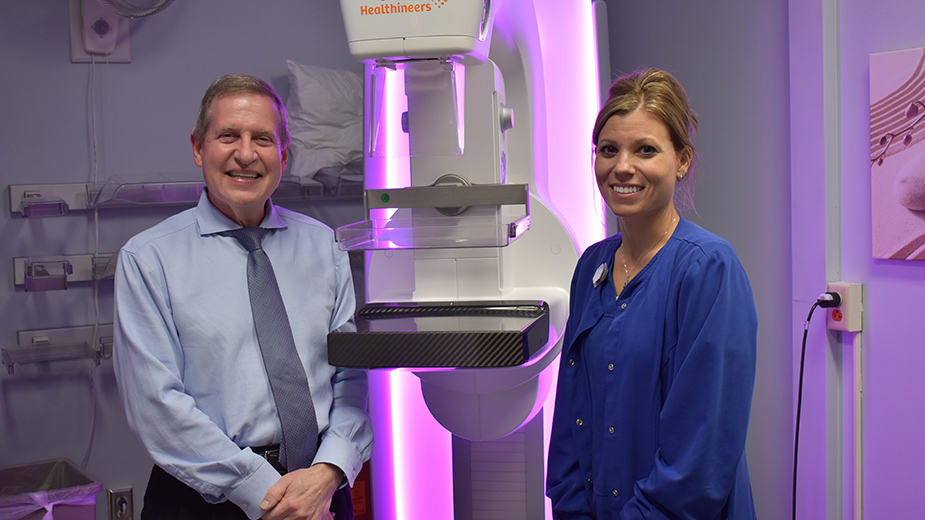YOUNGSTOWN, Ohio – Early detection of breast cancer using the best available tech-nology remains the best way to reduce deaths from the disease, medical personnel in the field agree. At the same time, there is a “decreased emphasis” on the kinds of clinical and self-performed breast exams that have been recommended for years.
According to the Ohio Department of Health’s 2023 cancer profile, the annual incidence rate for breast cancer per 100,000 in Mahoning County from 2016 to 2020 was 117.4 cases, compared to 129.5 cases statewide and 126.9 cases nationally. The mortality rate per 100,000 is 17.6 in Mahoning County, compared with 21 statewide and 19.6 nationally.
The 2023 state cancer profile showed 116.1 cases per 100,000 in Trumbull County, and a mortality rate of 20.6 cases. In Columbiana County, the incidence rate was 121.1 and the mortality rate was 19.0.
Luann Andamasaris, oncology coordinator at Trumbull Regional Medical Center in Warren, attributes improved local rates to better awareness of the importance of screenings.
“There are several hospitals in the area all trying to convey the message to the public,” adds Dr. Roger Tokars, radiation oncologist at Trumbull Regional.
“They used to be kind of adamant about doing monthly self-breast exams on ladies. They felt statistically that didn’t yield a lot of benefit, and that just going for the screening test helped detect things earlier than the self-exam,” Andamasaris says.
Instead, women are advised to “know their own breasts” and to be aware of any changes such as changes in the skin, swelling in one portion of a breast, changes in skin texture or an inversion in or drainage from the nipple.
“Breast awareness is definitely something people should be performing,” though not necessarily breast exams, Dr. Nicole Reyes affirms. Reyes is a breast surgeon who recently joined the Joanie Abdu Comprehensive Breast Care Center at St. Elizabeth Youngstown Hospital after completing her fellowship at the Cleveland Clinic.
“I really want to push that women need to know their body and be aware of their breasts, so that if something changes or something doesn’t feel right, that’s when they need to seek out help,” Reye says.
Screenings
Because of the Covid-19 pandemic, there was a period of about two years that women were reluctant to come to the hospital or visit their doctors, says Dr. Peter Apicella, chairman of the department of medical imaging at Salem Regional Medical Center.
Many eventually came in saying they knew they had a lump for a couple of years but didn’t know what to do about it, he continues. At that point the cancer had advanced to a stage that the survival rate was down to 70%.
“The challenge with the cancers was this would be similar to what would have happened in the 1970s or 1980s,” when patients would come in with “huge” cancers, Apicella says.
Many women may not know the screening recommendations. Those include annual screening mammograms for women at average risk starting at age 40, according to Reyes.
For women at a higher risk, mammograms and magnetic resonance imaging are alternated every six months. Factors placing women at higher risk would include family history, late menopause or having a first child after age 30, as well as smoking, excessive alcohol use, obesity or physical inactivity.
In place for at least 10 years, the recommendation for women at high risk from genetic family history or radiation exposure is to begin MRIs at age 25 and alternate between MRIs and mammograms at age 30, Apicella says.
“The insurance companies will now pay for breast cancer screening, which they would not do before, until [research] came up with this standardized way of saying you’re at high risk and you’re not,” he says
Technology in Screening
During the pandemic, Salem Regional upgraded its equipment and now is a showcase site for medical equipment manufacturer Siemens.
The use of newer 3D digital mammography, which uses multiple X-ray images, is particularly useful with dense breast tissue and detects cancer at earlier stages. In some cases, it detects cancer that a traditional mammogram would miss.
“If you can find it smaller, survival goes to 98% from 70%,” Apicella says. “It is life-changing when we find these small cancers.”
Apicella points to an example of a three-millimeter growth found in a patient’s breast. When the cancer is removed at that stage, the patient doesn’t require “chemo, radiation or anything, and they’re cured,” he says.
Salem Regional also employs the newest version of ultrasound, which has twice the resolution of older ultrasound, he says. In addition, the hospital uses a newer magnetic resonance imaging unit, a three-tesla MRI that has twice the resolution of others in the area.

“What we’re finding is cancers might be bigger than they look on a mammogram and there can be multiple cancers, and it totally changes management and workup,” he says.
Darla Habosky, lead therapist in the radiation oncology department at Trumbull Memorial Medical Center, says her hospital recommends 3D mammography starting at age 40.
“Any mammogram is good, but 3D is better,” she says especially for those with dense breasts.
Tokars agrees.
“With dense breasts you have a little higher risk for breast cancer,” he says. “It’s also more difficult to see with the standard mammogram.”
The high-risk category also includes anyone who has genetic mutations to the BRCA 1 or BRCA 2 gene or first-degree relatives with them, or anyone who has had chest radiation before the age of 30, Andamasaris says. Those women should start mammograms at age 30.
“Everyone should be getting 3D mammograms done at this point,” Reyes affirms. “Our main goal is to catch cancer early, which the only way to do that is with screening mammograms.”
Treatment
One of the two main surgical options is the mastectomy, which was “the treatment route they would go with many years ago,” Reyes says.
“Now the standard is breast conservation therapy,” she continues. That consists of a lumpectomy to remove the tumor, followed by radiation.
There are a lot of different directions being taken in the area of breast cancer treatment, says Tokars at Trumbull Regional. Among the biggest changes is decreasing the number of treatments – but at higher dosages – given to patients in earlier stages and achieving the same results. Advanced cancer though, would require more treatments. While less expensive than the higher number of treatments, the success in local control of the cancer as well as the cosmetic outcome is equivalent, he says.
Another thrust now is to do chemotherapy before surgery to treat advanced cancers and shrink tumors so they are easier to remove, he adds.
The American Society of Clinical Oncologists is also exploring an approach that integrates chemotherapies with immunotherapy. It uses antibody drug conjugates to tag the antibody onto the chemotherapy so the chemotherapy enters the cell and “delivers the payload” and kills the cancer cell.
“The takeaway is when a biopsy is done, and cancer is diagnosed, it has to be a team approach. [Patients] just can’t go to a surgeon and have surgery before any process is started,” Andamasaris says. “They need to see the whole team so the team can get together and make a decision about what treatment needs to be given first, second and third.”
Pictured at top: Dr. Peter Apicella and mammographer Chasney Miller show the Siemens 3D mammography unit at Salem Regional Medical Center.
